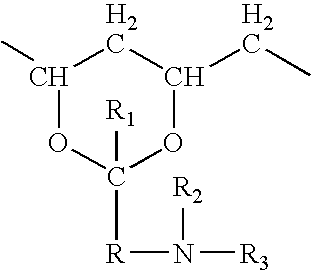Hydrogel biomedical articles
a biomedical article and hydrogel technology, applied in the field of biomedical articles, can solve the problems of inability to form in vivo, inconvenient long-term contact with tissues, inferior mechanical strength of devices,
- Summary
- Abstract
- Description
- Claims
- Application Information
AI Technical Summary
Problems solved by technology
Method used
Image
Examples
example 1
General Method for the Preparation of High-Acetate Products of the Reaction of PVA with Acetals or Aldehydes
[0128]300 g of PVA (Mowiol 4-88, unless stated otherwise) is introduced into a 2 liter twin-jacket reactor fitted with stirrer and thermometer, 800 g of demineralized water is added, and the mixture is warmed to 95° C. with stirring.
[0129]After one hour, all the reactants have dissolved to give a clear solution, which is cooled to 20° C. A crosslinkable acetal in the amount given in the examples, if desired together with one or more acetal(s), 440 g of acetic acid, 100 g of concentrated hydrochloric acid (37%) and sufficient demineralized water to give a total of 200 g of reaction solution are added. The mixture is stirred at 20° C. for 20 hours.
[0130]Isolation can be carried out by ultrafiltration. The reaction mixture is cooled to 15° C. and the pH is adjusted to 3.6 by means of aqueous NaOH (5%). The polymer solution is filtered through a 0.45 micron filter and purified by ...
example 2
General Method for the Preparation of Low-Acetate Products of the Reaction of PVA with Acetals or Aldehydes
[0132]300 g of PVA (Mowiol 4-88, unless stated otherwise) is introduced into a 2 liter twin-jacket reactor fitted with stirrer and thermometer, 800 g of demineralized water is added, and the mixture is warmed to 95° C. with stirring. After one hour, all the reactants have dissolved to give a clear solution, which is cooled to 20° C. A crosslinkable acetal in the amount given in the examples, if desired together with one or more acetal(s), 440 g of acetic acid, 100 g of concentrated hydrochloric acid (37%) and sufficient demineralized water to give a total of 2000 g of reaction solution are added. The mixture is stirred at 20° C. for 20 hours. After 20 hours, a sample of the reaction solution is titrated with NaOH, and the degree of hydrolysis of the PVA determined. HCl is 1.034 meq / g, acetic acid is 0.265 meq / g, corresponding to a residual acetate content of 3.5 mol %. The reac...
examples 3a , 3
Examples 3a, 3b, and 3c
High Acetate Macromers
[0135]The preparation method of example 1 was used. The macromers were isolated by ultrafiltration using a 1 kD membrane (Millipore). The PVA used was Mowiol 3-83 from Hoechst, residual acetate content 17 mol %, Mm 8,261, Mn 3,646, Mw / Mn 2.26, intrinsic viscosity [dl / g] 0.278.
[0136]3a): 30 g of acrylamidoacetaldehyde dimethyl acetal was used with 500 g of added acetic acid.
Macromer data (sol)
[0137]Intrinsic viscosity: [dl / g] of 0.329
[0138]N content: 0.79%
[0139]Acetal content: 0.62 meq / g
[0140]Acetate content: 15.3 mol %
[0141]Mw 18,500, Mn 6,735, Mw / Mn 2.74
[0142]Solids content: 30% in the sol state resulted in 30.2% in the gel state.
[0143]3b): 30 g of methacrylamidoacetaldehyde dimethyl acetal was used with 500 g of added acetic acid.
Macromer data (sol)
[0144]Intrinsic viscosity: [dl / g] of 0.282
[0145]N content: 0.789%
[0146]Acetal content: 0.57 meq / g
[0147]Acetate content: 2.81 meq / g, corresponding to 15.1 mol %
[0148]Mw 14,151, Mn 5652, M, / Mn...
PUM
| Property | Measurement | Unit |
|---|---|---|
| time | aaaaa | aaaaa |
| temperature | aaaaa | aaaaa |
| size | aaaaa | aaaaa |
Abstract
Description
Claims
Application Information
 Login to View More
Login to View More - R&D
- Intellectual Property
- Life Sciences
- Materials
- Tech Scout
- Unparalleled Data Quality
- Higher Quality Content
- 60% Fewer Hallucinations
Browse by: Latest US Patents, China's latest patents, Technical Efficacy Thesaurus, Application Domain, Technology Topic, Popular Technical Reports.
© 2025 PatSnap. All rights reserved.Legal|Privacy policy|Modern Slavery Act Transparency Statement|Sitemap|About US| Contact US: help@patsnap.com



